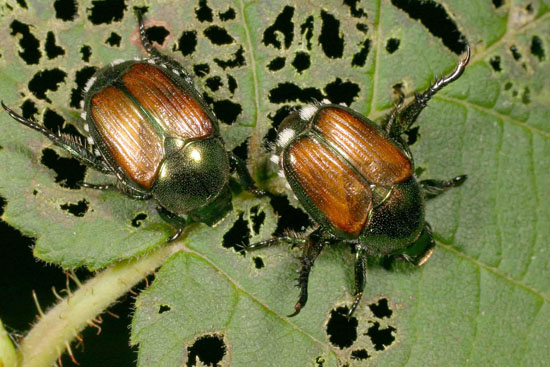Issue 9, June 21, 2013
Japanese Beetle Adult Emergence
Japanese beetle adults should be emerging in southern Illinois and will be emerging in central Illinois during the last week of June. They will emerge in northern Illinois during the first week of July. Look for them first on golf courses and other well-watered turf and then on smartweed, one of their favorite host plants.

Japanese Beetle Adults on grape
Overall numbers of adults are likely to be lower this year due to last summer’s drought. Eggs are laid by the adult females burrowing into the soil after mating. They tends to select areas of green grass and moist soil. Egg-laying apparently occurs primarily during the first two weeks of July in central Illinois, with first instar larvae hatching from them by early August. This timing is slightly earlier for southern Illinois and slightly later for northern Illinois.
The eggs take in water from the soil and expand after being laid. In dry soils, this does not occur completely, and many eggs do not hatch. In addition, the larvae (grubs) require eleven inches of rainfall or irrigation through the late summer into the fall to mature to the third larval instar and survive the winter.
I was surprised and encouraged last summer that very few home lawns were watered enough during the drought to be green and lush. Most were watered sparingly, enough to keep the grass alive, and some appeared to have not been watered at all. On a trip from Pontiac to Urbana in mid-July last summer, I drove by hundreds of lawns looking to get a photo of a watered next to an unwatered lawn. I could not find any heavily irrigated lawns until I was almost to Urbana and located a new housing development where irrigation was needed to keep the new lawns alive. Even sparsely irrigated turf last summer likely did not receive the required eleven inches of moisture, so most Japanese beetle grubs that hatched probably perished.
There will be heavy emergence of adult Japanese beetles from areas that were irrigated last summer, but many of these, such as golf courses, were probably treated for grubs resulting in greatly reduced grub survival in those areas. Untreated turf areas that receive enough rain for the grubs to survive are probably the major source of Japanese beetle adults from year to year. Most of those areas did not receive enough moisture last year for the grubs to survive.
East central Illinois has experienced lower than expected Japanese beetle adult numbers for several years now. This phenomenon extends across central Indiana and most of central Ohio. It may also be spreading farther west in Illinois as well. Previously, the western edge of this phenomenon appeared to be at about Monticello, but reports of fewer beetles in the Springfield area last year may be an indication that it is moving west. The band of reduced emergence appears to extend from about Paxton on the north to Charleston on the south.
Grubs, beetles, and soils have been checked for pathogens, chemicals, and other likely causes with no results. The reduced beetle numbers remain a mystery. In previous years, none of the normal causes for population reductions have been seen including frozen winter soils, dry summer soils, and milky spore disease. Japanese beetle is one of the most heavily researched insects in the world, but this illustrates that life always has additional things to teach us.
More information on Japanese beetles and their control on woody ornamentals can be found at http://hyg.ipm.illinois.edu/article.php?id=377.
Author:
Phil Nixon